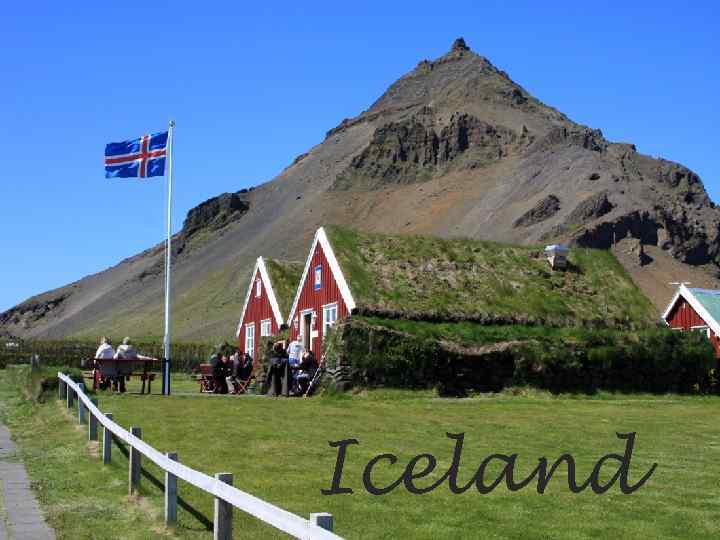 { Iceland
{ Iceland
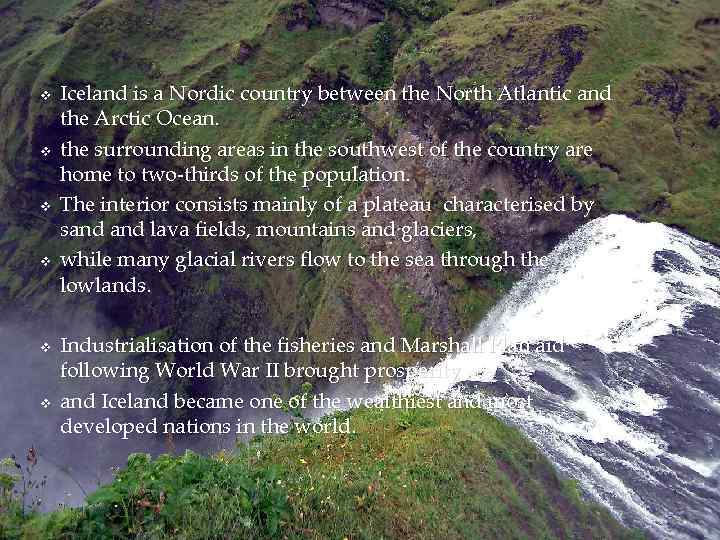 v v v Iceland is a Nordic country between the North Atlantic and the Arctic Ocean. the surrounding areas in the southwest of the country are home to two-thirds of the population. The interior consists mainly of a plateau characterised by sand lava fields, mountains and glaciers, while many glacial rivers flow to the sea through the lowlands. Industrialisation of the fisheries and Marshall Plan aid following World War II brought prosperity and Iceland became one of the wealthiest and most developed nations in the world.
v v v Iceland is a Nordic country between the North Atlantic and the Arctic Ocean. the surrounding areas in the southwest of the country are home to two-thirds of the population. The interior consists mainly of a plateau characterised by sand lava fields, mountains and glaciers, while many glacial rivers flow to the sea through the lowlands. Industrialisation of the fisheries and Marshall Plan aid following World War II brought prosperity and Iceland became one of the wealthiest and most developed nations in the world.
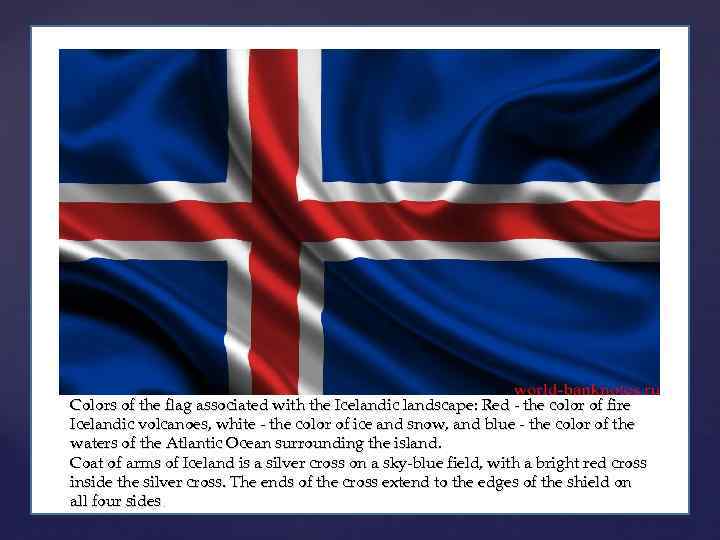 Colors of the flag associated with the Icelandic landscape: Red - the color of fire Icelandic volcanoes, white - the color of ice and snow, and blue - the color of the waters of the Atlantic Ocean surrounding the island. Coat of arms of Iceland is a silver cross on a sky-blue field, with a bright red cross inside the silver cross. The ends of the cross extend to the edges of the shield on all four sides.
Colors of the flag associated with the Icelandic landscape: Red - the color of fire Icelandic volcanoes, white - the color of ice and snow, and blue - the color of the waters of the Atlantic Ocean surrounding the island. Coat of arms of Iceland is a silver cross on a sky-blue field, with a bright red cross inside the silver cross. The ends of the cross extend to the edges of the shield on all four sides.
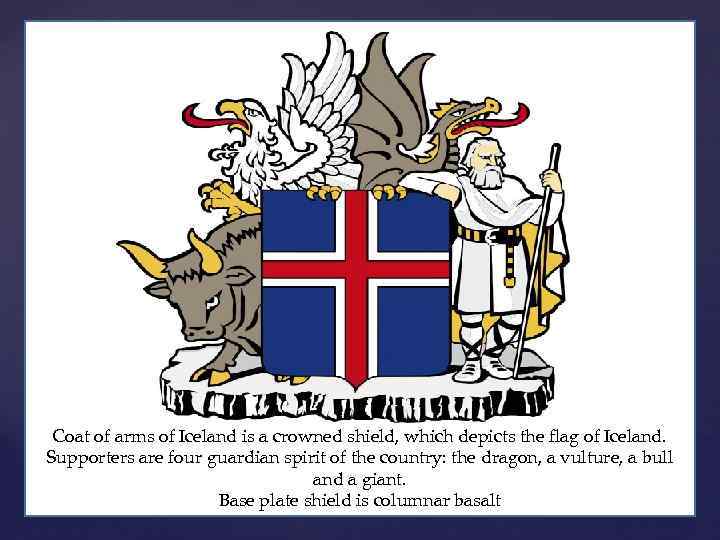 Coat of arms of Iceland is a crowned shield, which depicts the flag of Iceland. Supporters are four guardian spirit of the country: the dragon, a vulture, a bull and a giant. Base plate shield is columnar basalt
Coat of arms of Iceland is a crowned shield, which depicts the flag of Iceland. Supporters are four guardian spirit of the country: the dragon, a vulture, a bull and a giant. Base plate shield is columnar basalt
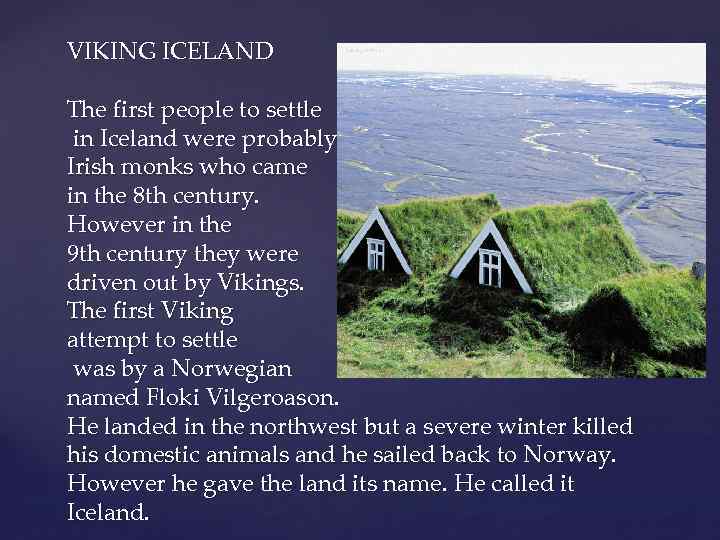 VIKING ICELAND The first people to settle in Iceland were probably Irish monks who came in the 8 th century. However in the 9 th century they were driven out by Vikings. The first Viking attempt to settle was by a Norwegian named Floki Vilgeroason. He landed in the northwest but a severe winter killed his domestic animals and he sailed back to Norway. However he gave the land its name. He called it Iceland.
VIKING ICELAND The first people to settle in Iceland were probably Irish monks who came in the 8 th century. However in the 9 th century they were driven out by Vikings. The first Viking attempt to settle was by a Norwegian named Floki Vilgeroason. He landed in the northwest but a severe winter killed his domestic animals and he sailed back to Norway. However he gave the land its name. He called it Iceland.
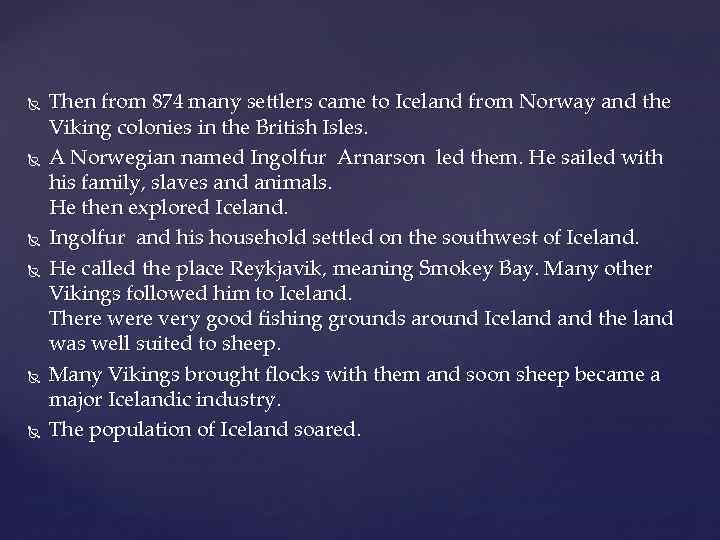 Then from 874 many settlers came to Iceland from Norway and the Viking colonies in the British Isles. A Norwegian named Ingolfur Arnarson led them. He sailed with his family, slaves and animals. He then explored Iceland. Ingolfur and his household settled on the southwest of Iceland. He called the place Reykjavik, meaning Smokey Bay. Many other Vikings followed him to Iceland. There were very good fishing grounds around Iceland the land was well suited to sheep. Many Vikings brought flocks with them and soon sheep became a major Icelandic industry. The population of Iceland soared.
Then from 874 many settlers came to Iceland from Norway and the Viking colonies in the British Isles. A Norwegian named Ingolfur Arnarson led them. He sailed with his family, slaves and animals. He then explored Iceland. Ingolfur and his household settled on the southwest of Iceland. He called the place Reykjavik, meaning Smokey Bay. Many other Vikings followed him to Iceland. There were very good fishing grounds around Iceland the land was well suited to sheep. Many Vikings brought flocks with them and soon sheep became a major Icelandic industry. The population of Iceland soared.
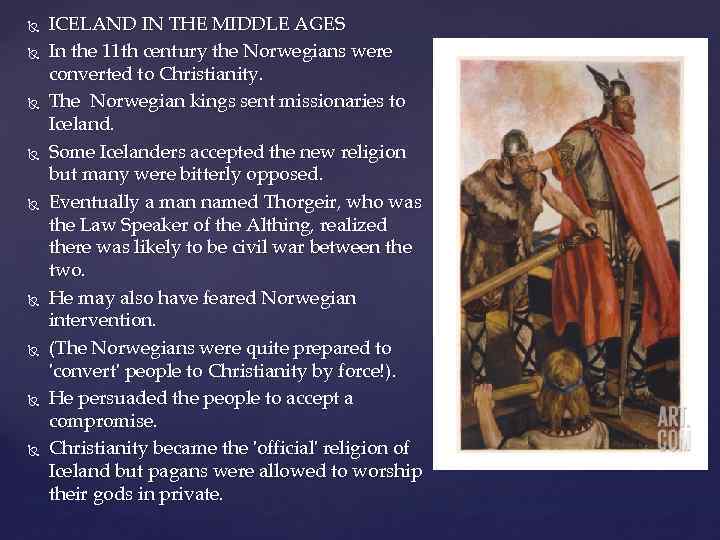 ICELAND IN THE MIDDLE AGES In the 11 th century the Norwegians were converted to Christianity. Тhe Norwegian kings sent missionaries to Iceland. Some Icelanders accepted the new religion but many were bitterly opposed. Eventually a man named Thorgeir, who was the Law Speaker of the Althing, realized there was likely to be civil war between the two. He may also have feared Norwegian intervention. (The Norwegians were quite prepared to 'convert' people to Christianity by force!). He persuaded the people to accept a compromise. Christianity became the 'official' religion of Iceland but pagans were allowed to worship their gods in private.
ICELAND IN THE MIDDLE AGES In the 11 th century the Norwegians were converted to Christianity. Тhe Norwegian kings sent missionaries to Iceland. Some Icelanders accepted the new religion but many were bitterly opposed. Eventually a man named Thorgeir, who was the Law Speaker of the Althing, realized there was likely to be civil war between the two. He may also have feared Norwegian intervention. (The Norwegians were quite prepared to 'convert' people to Christianity by force!). He persuaded the people to accept a compromise. Christianity became the 'official' religion of Iceland but pagans were allowed to worship their gods in private.
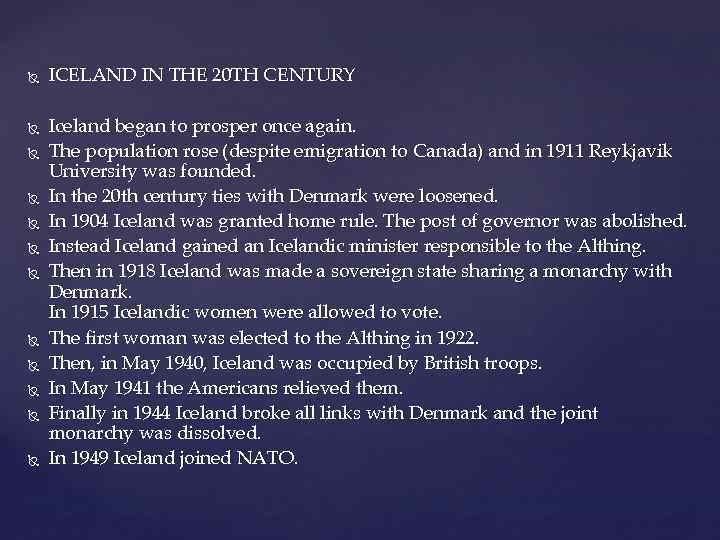 ICELAND IN THE 20 TH CENTURY Iceland began to prosper once again. The population rose (despite emigration to Canada) and in 1911 Reykjavik University was founded. In the 20 th century ties with Denmark were loosened. In 1904 Iceland was granted home rule. The post of governor was abolished. Instead Iceland gained an Icelandic minister responsible to the Althing. Then in 1918 Iceland was made a sovereign state sharing a monarchy with Denmark. In 1915 Icelandic women were allowed to vote. The first woman was elected to the Althing in 1922. Then, in May 1940, Iceland was occupied by British troops. In May 1941 the Americans relieved them. Finally in 1944 Iceland broke all links with Denmark and the joint monarchy was dissolved. In 1949 Iceland joined NATO.
ICELAND IN THE 20 TH CENTURY Iceland began to prosper once again. The population rose (despite emigration to Canada) and in 1911 Reykjavik University was founded. In the 20 th century ties with Denmark were loosened. In 1904 Iceland was granted home rule. The post of governor was abolished. Instead Iceland gained an Icelandic minister responsible to the Althing. Then in 1918 Iceland was made a sovereign state sharing a monarchy with Denmark. In 1915 Icelandic women were allowed to vote. The first woman was elected to the Althing in 1922. Then, in May 1940, Iceland was occupied by British troops. In May 1941 the Americans relieved them. Finally in 1944 Iceland broke all links with Denmark and the joint monarchy was dissolved. In 1949 Iceland joined NATO.
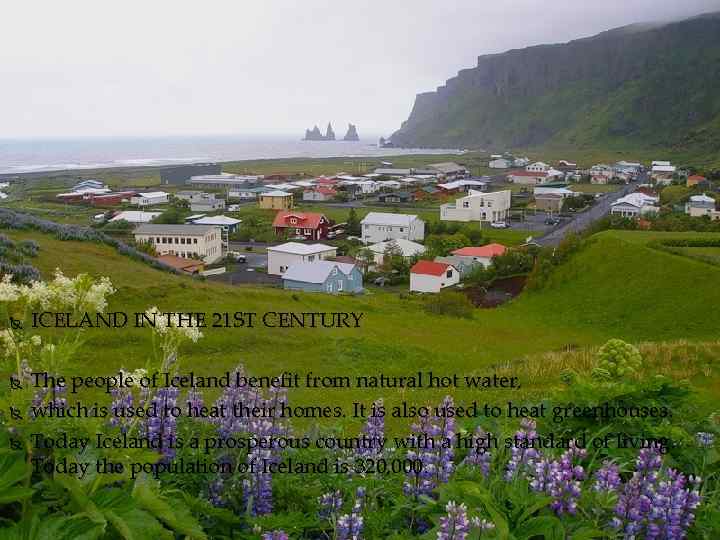 ICELAND IN THE 21 ST CENTURY The people of Iceland benefit from natural hot water, which is used to heat their homes. It is also used to heat greenhouses. Today Iceland is a prosperous country with a high standard of living. Today the population of Iceland is 320, 000.
ICELAND IN THE 21 ST CENTURY The people of Iceland benefit from natural hot water, which is used to heat their homes. It is also used to heat greenhouses. Today Iceland is a prosperous country with a high standard of living. Today the population of Iceland is 320, 000.


